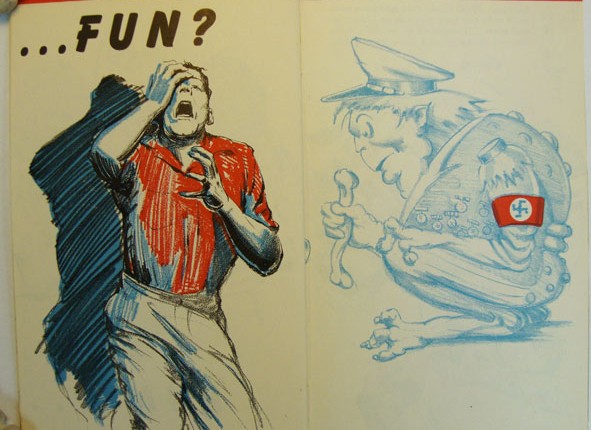
By Nina M. Schneider, Head Cataloger
Recently, the news has been filled with reports of the possibility of a new Cold War, while at the same time updating us about the ongoing search for Malaysian Airlines’ missing jet. It might be a coincidence then, that while cataloging Ward Ritchie’s Library, our interns ran across job instruction booklets from the early days of the Douglas Aircraft Company.
Three-quarters of the way through her 30-month internship, Patricia Garcia discovered an incomplete set of printed instructions published in 1943 by the Education Department of The Douglas Aircraft Company. Job Instruction No. 1: Safetying with Cotter Pins explains the right way to “safety a bolt” and “how to safety a clevis pin” with hand-drawn illustrations, printed in red and black.

Job Instruction No. 2: Riveting, emphasizes the importance of the matching the tool to the rivet and the deadly consequence of laziness, inattentiveness, or hiding a broken part.
The Clark has two copies of the second pamphlet, one produced for Douglas Aircraft, the other for the Education Department of the Consolidated-Vultee Aircraft Corp, Vultee Field Division. Both covers feature a photograph of a female employee (the original Rosie?) using a rivet gun. Interestingly, the copy produced for Douglas Aircraft has an altered cover. The woman’s hair is covered by a hairnet, but a hairnet that is printed letterpress.

The Clark also has two copies of Job Instruction No. 3: Drilling. This time, the model is wearing an actual hairnet for the cover photo as she wields what looks like a 40-pound drill while wearing a cashmere cardigan over a lace-edged blouse. In fact, many of the booklets that we have from the defense contractor feature instructions for women.
Job Instruction No. 9: Hints to Women Aircraft Workers stresses the importance of workplace safety and life-style practices. Looking at this book seventy years later makes us cringe. Of course, some of the advice is common sense; new working habits and different types of physical labor will likely result in sore muscles and fatigue. However, the manual warns that fatigue should be avoided because it leads to mistakes, and mistakes can be deadly. Their advice: Eat something sweet for a boost of energy, stretch, or take a hot bath, and “don’t wear yourself out on exercise.” This booklet also shows some stretches that can be done for “menstrual adjustments.” In the mix of diagrams and cartoons about the proper way to lift heavy loads, work ergonomically, and properly handle tools, are hints on makeup, shoes, and jewelry in the workplace, the importance of daily baths and using deodorant, and the types and proper amounts of food consumed in a daily diet.
Contrast this booklet with Job Instruction No. 11: X Marks the Spot. Fully illustrated in black, red, and blue, employees are menaced on every page by the lurking presence of caricaturized monsters from Japan and Germany.

Long, loose hair can be caught in moving drills bits, zoot suits have too many pockets, neckties invite disaster when operating lathes, and wedding rings can get caught in a revolving chuck.

In fact, all sorts of disasters can happen when employees don’t follow regulations or improperly use heavy equipment. The enemy is just waiting for disaster to happen!


The font is a modern, bold, sans serif face for each booklet. Uniformly sized in an 8×5” format, with rounded fore-edge corners and a stapled spine, these booklets were likely designed and printed by Ward Ritchie.
As stated in the biographical sketch for the Ward Ritchie collection of papers: Ritchie became one of the principal figures in the fine-printing movement in Southern California. [A native of Los Angeles, he studied at Occidental College and Stanford and spent a semester at Frank Wiggins Trade School learning to print. After an apprenticeship in France, he returned to Los Angeles and] printed for the Primavera Press, [while taking] commissions as the Ward Ritchie Press, which he incorporated in 1932. Gregg Anderson entered into partnership, and the printing firm was subsequently called Anderson & Ritchie, with the name Ward Ritchie Press being retained for publishing ventures. At the outbreak of World War II, Anderson joined the Army (he was killed in 1944), and Ritchie left the press for Douglas Aircraft, where he produced technical manuals. … Between 1943 and 1950 Ritchie worked as production manager at the advertising agency Foote, Cone and Belding, though he remained associated with the press and did designs for them. In 1950 he returned to the press full-time, and the firm (renamed Anderson, Ritchie & Simon) kept growing until Ritchie retired in 1972. … In his retirement, in Laguna Beach, he bought a hand press and began printing small editions himself under the name Laguna Verde Imprenta. He died early in 1996 [leaving behind two wives, two children, three step-children and his close friend, Gloria Stuart].
Douglas Aircraft Company was founded in 1921 and was headquartered in Santa Monica. It became McDonnell Douglas when it merged with McDonnell Aircraft in 1967.
For more information on the Ward Ritchie Library, search “Press coll. Ritchie Lib.” as a call number in the UCLA Library catalog. See also the online finding aid for his papers.
For more information about Douglas Aircraft, see the Museum of Flight’s website.






